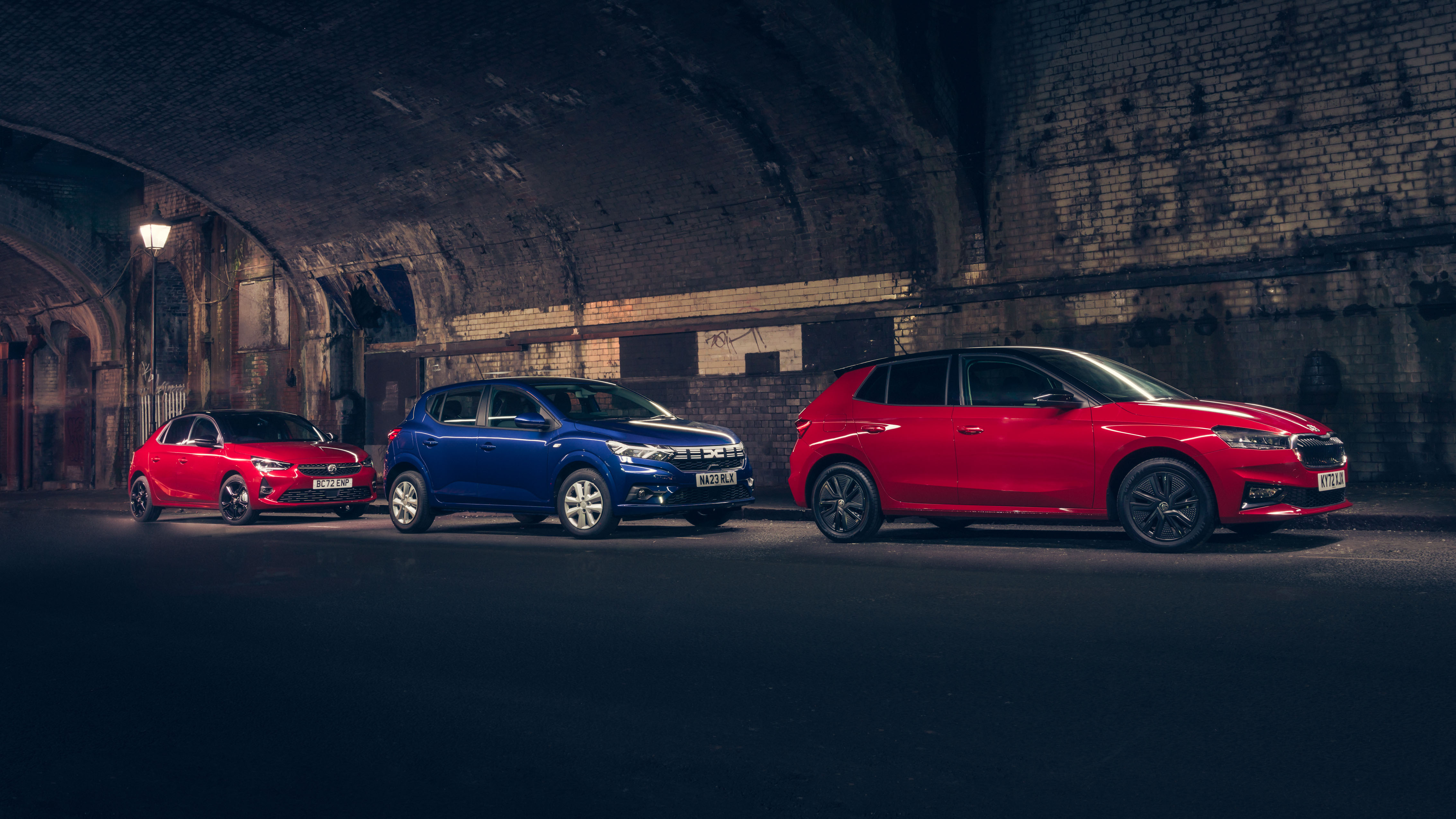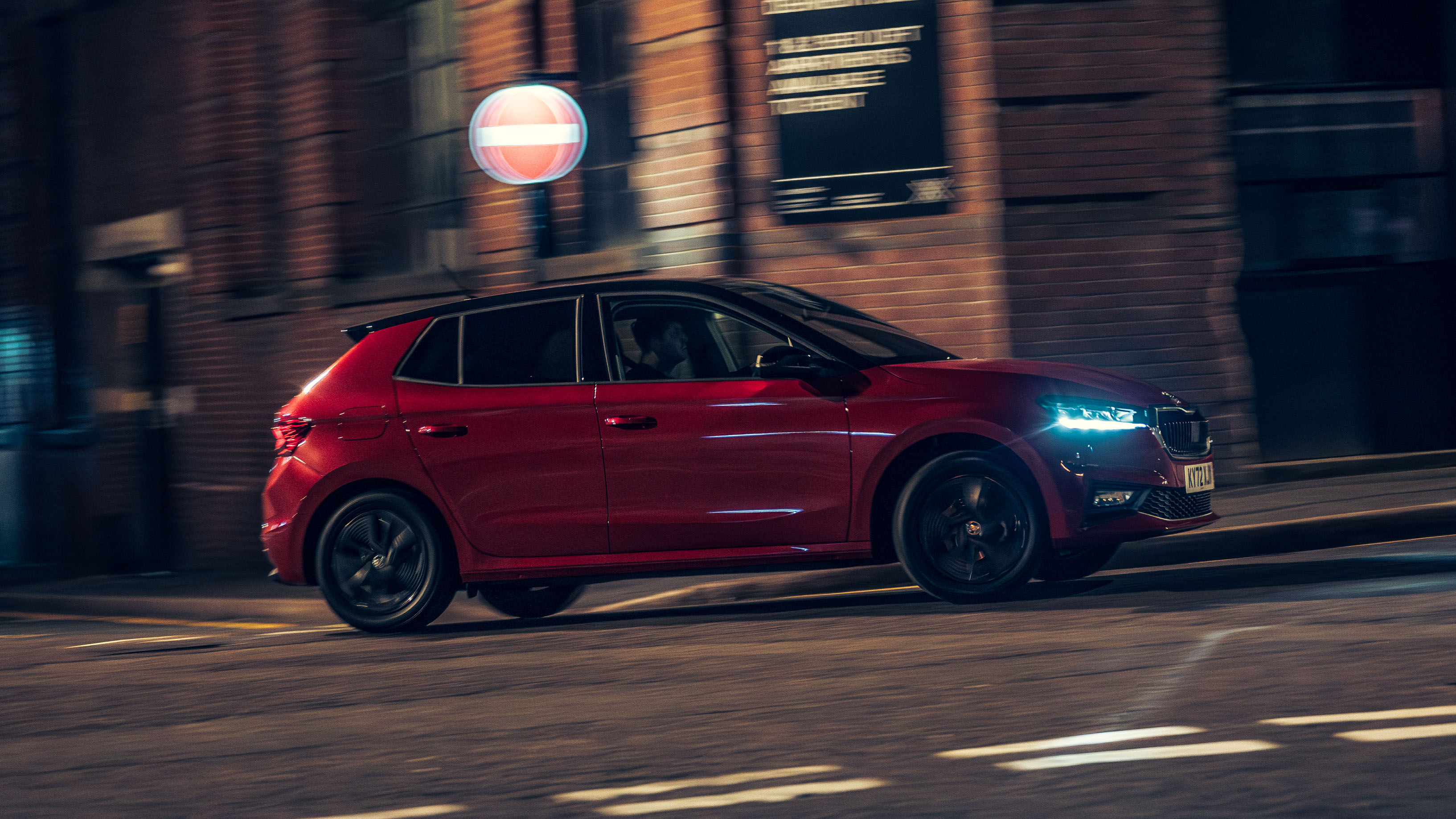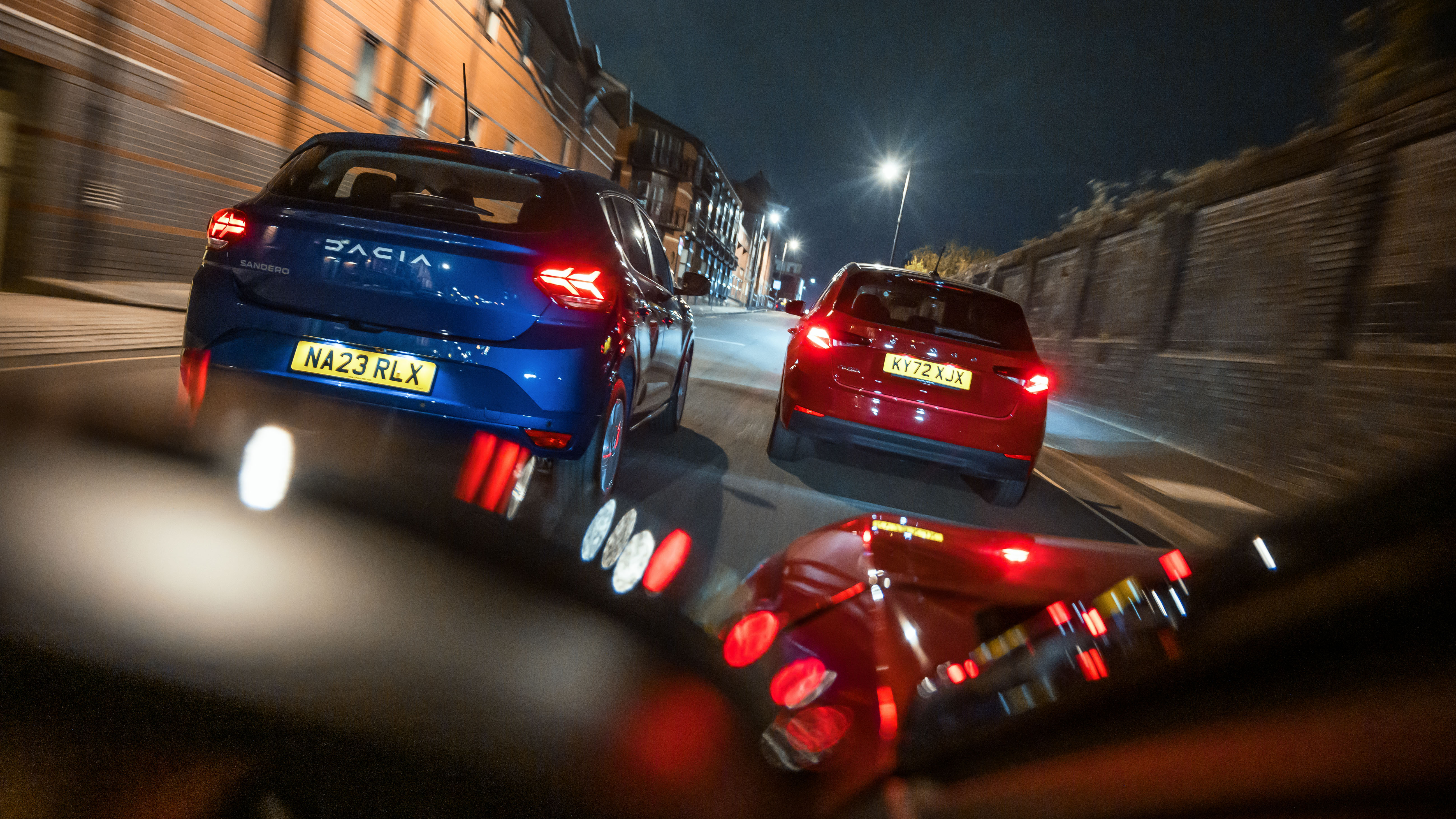
Battle of the superminis: Vauxhall Corsa vs Dacia Sandero vs Skoda Fabia
After nearly 50 years, the Ford Fiesta is dead, so long live the... wait, which of the current crop of superminis should we go for?
RIP - after 47 years of ubiquity Ford’s Fiesta has come off sale (cutthroat business this, no room for sentimentality) thanks to barely controlled inflation. Not the economic kind, though that can’t be helping, rather the fact that cars are getting too big. People want high riding SUVs, or more spacious, well appointed hatchbacks. Throw in ever stricter emissions rules and making a supermini at lower volumes is getting too expensive. Can’t blame Ford for deciding it couldn’t be bothered.
The Fiesta was long the default choice – you could recommend it to anyone and they'd be happy. There's no obvious natural successor, but we've brought together the cheap one, the all-rounder and the current UK bestseller (although it was dethroned by the Ford Puma while we were writing this) to see if the crown fits any of the rivals, or whether the Fiesta’s demise marks the end of an era. The cheap one is the £14,795 Dacia Sandero in top spec (as if it makes a difference) Expression trim, showing off its recent facelift courtesy of the budget brand’s nimble lifestyle-oriented pivot. Not the kitesurfing and spelunking that rivals seem to think we get up to at the weekend, but rather tramping about in the woods with the dog while the kids ride their scooters into a tree.
Skoda must be fuming - fewer people saw Dacia's Soviet-spec output lumbering about Romania in the early Nineties in the same way the likes of the Skoda Favorit haunted middle-sized British towns. But Skodas are right posh now, even if it's taken a while to pull off - the Fabia's the fanciest here, but not the most expensive. It's £19,850 in penultimate Colour Edition spec and we know it's a great all-rounder because that’s the award we gave it back in 2022 – it’s become the automatic suggestion of an inoffensively pleasant new car to go for since the Volkswagen Golf was edged off into the rough.
Photography: Olgun Kordal
The bestseller, surprisingly, is the Vauxhall Corsa, but then someone has to be in first place, that’s how lists work. The Fiesta’s ignominious toppling from its (very) long-time sales chart domination is the thing here, made all the worse by being at the hands of its archenemy. Supply issues, economic malaise, COVID-19, bad weather – there are all sorts of factors involved in the decline of the UK new car market – and the Corsa’s numbers haven’t dropped as far or as fast as others. At £22,135 it’s the most expensive here, so there must be some secret sauce to its popularity, because it isn’t the low, low prices.
Interestingly these three are notable by something the Fiesta never managed – platform sharing. The Corsa shares its bits with the likes of the Peugeot 208 and Citroen C3 thanks to the E-GMP platform at Stellantis, while the Fabia’s MQB platform underpins dozens of Volkswagen Group models. The Dacia Sandero’s CMF-B engineering is a bargain bin version of what they use in the Renault Clio and Nissan Juke, among others.
So what are these cars actually for? They seem to occupy a similar portion of the market, but then they appeal to seemingly very different audiences. The Corsa’s always been your classic first car, the latest Fabia positioned ready to catch people downsizing from larger cars and the Sandero is the spreadsheet choice for young families or the elderly. Anyone who sits 5mph below the speed limit, really.
All three come fairly well equipped at these trim levels – such niceties as Apple/ Android connectivity, aircon and touchscreen infotainment (8.0 inches in the Dacia and Skoda, 7.0 in the Vauxhall) as standard, but with differing vibes to go along with the snap judgements we’ve made before getting in. The Corsa’s cabin fails to live up to the promise of the exterior styling, offering no discernible personality save for some GS trim-specific red stripes across the dash and chairs. There’s some perfunctory storage, and at least the virtue of physical controls for the heating and ventilation. Rear space isn’t brilliant, either – best save those lifts for city jaunts, let grandma sit in the front. It’s a functional car that’ll blur into the background of the everyday.
So it’s down to the Skoda to bring the pizzazz – what’s great about this generation of Fabia is that it feels like some people have sat down together and brainstormed ideas that’ll genuinely make your life a fraction better. The little parking ticket clip on the windscreen, the pen loop by the gearstick or the surprise and delight features you’ll be showing your friends – the umbrella in the driver’s door and ice scraper in the fuel filler cap. You can go crazy on the options list and get a little bin for the door pocket or a cargo net that goes underneath the rear parcel shelf. It’s not all great inside – this car had the same heinous squeaking rattle from the nether regions of the dash as the long-termer we ran towards the end of 2022, and the morning after our night shoot the car had been sitting in the sunshine and the infotainment and digital dashboard were incoherent until we’d run the aircon for 15 minutes or so and calmed things down. It can be a bit of a Stepford car, this.
No sparkle in the Sandero, just the fuzzy glow of money saved. Buzzes and creaks aplenty, but that only adds to the thrift-soaked ambience. Sorry Skoda, we don’t make the rules. Dacia doesn’t have a Little Details sub-committee though, you’ll take what you’re given. The plastics here are a league below the other two, but the fabric on the dash is a neat attempt at disguising it. There’s a nice little phone holder next to the central touchscreen... which then mirrors your smartphone anyway. The USB socket behind the touchscreen means wires trailing about the dash, the seats are a little flat, the clutch pedal a bit high... the Sandero is perfectly fine for dashing about town, but the longer you spend in it at once the more you’ll be wishing you spent a little extra on something more rounded. There’s more rear seat space in here than any of the others, though.
Top Gear
Newsletter
Thank you for subscribing to our newsletter. Look out for your regular round-up of news, reviews and offers in your inbox.
Get all the latest news, reviews and exclusives, direct to your inbox.
These three are all great urban companions – each of them fairly wieldy, coming in at a smidge under 1,100kg (practically nothing by today’s porky standards) and suitable for chucking around side streets and gyratory systems. The Corsa’s handling is a surprise if you’ve driven older versions, much keener than it’s ever been. The Sandero has a sharp turn-in too, albeit let down by a touch of lean. Parking’s a cinch – they all have rear parking sensors, the Sandero even throws in a rear camera.
Venture beyond the suburbs and they’re surprisingly grown-up at a cruise too. Well, the Corsa and the Skoda are, the Dacia not so much. The Corsa’s quiet on the motorway, feels stable at a clip and has lovely manners. You wouldn’t think twice about taking it home to visit your family, however far away. Same story with the Fabia, even if its five-speed manual is one short of the Vauxhall. It’s the one you’d spend the most time in – sensible and well thought through, you know you’re in safe hands. The Sandero isn’t bad on a long journey per se, it just feels like it’s from a generation or two ago. The driving position is nigglingly off and there’s nowhere to shove your clutch foot when it’s not busy. The Dacia’s a good 50mm taller than the Fabia, looms over the Corsa by 70mm – it’s practically an SUV, but that has a knock-on effect when it comes to side winds, cornering lean, etc.
When we say cars like the Corsa or Fabia feel grown-up to drive, that’s in contrast to cars like the Sandero. They’re all three-cylinder small capacity petrols with turbochargers, but the Corsa feels the perkiest, at 9.3secs to 62mph from rest. The Fabia is 1.3secs slower than that, the Sandero 1.6secs further behind with a 12.2secs run. The first two are confident around town, zipping around with a little in hand where the Sandero feels wheezy, always catching up. The Skoda has the most pleasingly mechanical gear change, where the Dacia’s feels crunchy, with slack in the stick that means you don’t always know what gear you’re in. All three smother city potholes and speed bumps surprisingly well.
There’s a sophistication to the Fabia and Corsa – you can feel that they’ve been up against the class leading Fiesta for years, and drawing inspiration from larger, more accomplished cars on the market – the Dacia’s more of an arriviste. None drives as well as the Ford, but we’ll have a plentiful secondhand supply of those for a while yet if handling is the ultimate priority. The Sandero’s focus is elsewhere – costs, perhaps. Not insignificant now, with the pressures people are under – its list price is miles below the other two, now one of four cars on the market below £15k (along with the Fiat Panda, Citroen C3 and Kia Picanto). On a three-year plan, with 10,000 miles a year and six months’ worth of payments down the Sandero can be had for £238 a month, versus £319 for the Fabia and £349 for the Corsa. There are of course cheaper versions, and lower payments with a bigger deposit. All three sit squarely in VED Band G thanks to 120g/km-ish CO2 emissions – £210 in the first year and £180 after that. Their fuel consumption is broadly similar – the Sandero’s on top with 53.2mpg, the Fabia tight behind at 53.1mpg. The Corsa’s 49.6mpg is the least impressive on paper, but with its six gears it’ll sip along the motorway. Conversely the Sandero loses out if you’re having to thrash it to keep up with traffic.
And the Fiesta’s crown? The Corsa has managed to talk itself out of contention here by being so relentlessly average – a successful sales strategy, we suppose, but not one that we admire. There’s a facelift coming later in 2023, though we’re not sure it’ll address many of the Corsa’s issues. The winner here ultimately comes down to whether you put the priority on useful everyday practicality or outright cost. There’s little wrong with the Dacia that can’t be excused by its price... but then we do love that little umbrella in the Skoda’s door.
1: Skoda Fabia Colour Edition 1.0 TSI 95 - 8/10
Skoda's smallest is by no means perfect, but it's a great all-rounder with some nice little touches inside
2: Dacia Sandero Expression TCe90 - 8/10
The Sandero's schtick is its budget price, so the new lifestyle branding is odd, but the car has a certain charm
3: Vauxhall Corsa GS 1.2 Turbo - 6/10
Vauxhall's big seller remains as average as ever - it's not a bad car as such, it's just not very interesting
Trending this week
- Car Review
BMW iX3










